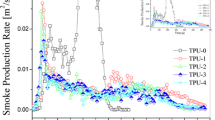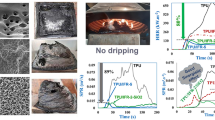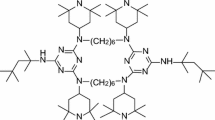Abstract
Char formation that preserves the structural integrity of the polymer is one of the most efficient methods of reducing its flammability. Enhanced char formation from polymers such as PVC may also be associated with a decrease in smoke production, as is observed when the polymer is modified by a flame retardant smoke suppressant (FRSS) complex. A correlation had been made between the FRSS characteristics and char morphology. The effect of different flame retardant smoke suppressants on char formation has been highlighted.
Similar content being viewed by others
References
Hirschler, M. M., ‘Soot from Fires: I. Properties and Methods of Investigation,’ Journal of Fire Science, 3 (1985), pp. 343–374.
Cullis, C. F. and Hirschler, M. M., The Combustion of Organic Polymers, The Oxford University Press, Oxford, (1981)
Lawson, D. F., Flame Retardant Polymeric Materials, eds. Lewin, M., Atlas, S. M. and Pearce, E. M. (eds), New York: Plenum Press, 1982. pp. pp 39–95.
Clements, W. R., Huang, J. M. G., and Capwell, R. J., ‘High Performance Flame Retardant/ Smoke Suppressant Additives: Char, Smoke and Off-Gas Studies,’ Japan Conference on Polymers and Plastics, Tokyo, 101–105, (July 1980)
Sharma, Sunil K., Patwardhan, A. K., and Srivastava, S. K., ‘Correlation Between FRSS Characteristics of Plasticized PVCs and Their Char Morphology,’ ASIAFLAM 95, Interscience Communications Limited, London, 1995, pp. 555–560.
Sevecek, P., and Dvorak, P., ‘The Composition and Structure of Solid Char Residue after Thermal Degradation of Polystyrene, PVC and Polyamide,’ Fire and Materials, 9 (1985), pp. 145–149.
Hornsby, P. R. and Watson, C. L., ‘Magnesium Hydroxide: A Combined Flame Retardant and Smoke Suppressant Filler for Thermoplastics,’ Plastics and Rubber Processing and Applications, 6, (1986), pp. 169–175.
Michel, A., Bert, M., Guyot, A. and Lahaya, J., ‘Nature of Carbonaceous Part of Smoke in Combustion of Rigid PVC: Effect of Copper Oxide as Smoke Suppressor,’ J. Fire and Flamm, 12 (1981), pp. 72–80.
Rochow, E. G., Inorganic Synthesis, #6, McGraw Hill, 1960, pp. 147–148; Moeller, T., Inorganic Synthesis, #5, McGraw Hill, 1957, pp. 113–116, 130–131, 188–189; Fernelius, W. C., Inorganic Synthesis, #2, McGraw Hill, 1946, pp. 121–122.
Bert, M., Michel, A. and Guyot, A., ‘Reduction of Smoke Generation in Poly (vinyl chloride) Combustion,’ Fire Res., 1 (1977/78), pp. 301–311.
Sharma Sunil K., Singh, M. P., Saxena N. K., and Srivastava, S. K., ‘Assessment of Effectiveness of Smoke Suppressants: Using a He Ne Laser in a Flow System,’ Fire Mater., 17,6 (1993), pp. 271–277.
Kroenke, W. J., Metal Smoke Retarders for Poly (vinyl chloride), J. Appl. Polym Sci., 26 (1981), pp. 1167–1190.
Cullis, C. F., Gad, A. M. M., and Hirschler, M. M., ‘Metal Chelates as Flame Retardants and Smoke Suppressants for Thermoplastic Polymers,’ Eur. Polym. J., 20,7 (1984), pp. 707–711.
Sharma, Sunil K., and Sharma, T. P., ‘Morphological Features of Carbonaceous Residue: A Possible Tool to Understand FRSS Characteristics of PVC,’ unpublished paper.
Author information
Authors and Affiliations
Additional information
(UP)
Rights and permissions
About this article
Cite this article
Sharma, S.K., Sharma, T.P. The Effect of Flame Retardant Smoke Suppressants on the Char Morphology of Plasticized PVC. Fire Technology 35, 276–285 (1999). https://doi.org/10.1023/A:1015440611340
Issue Date:
DOI: https://doi.org/10.1023/A:1015440611340




